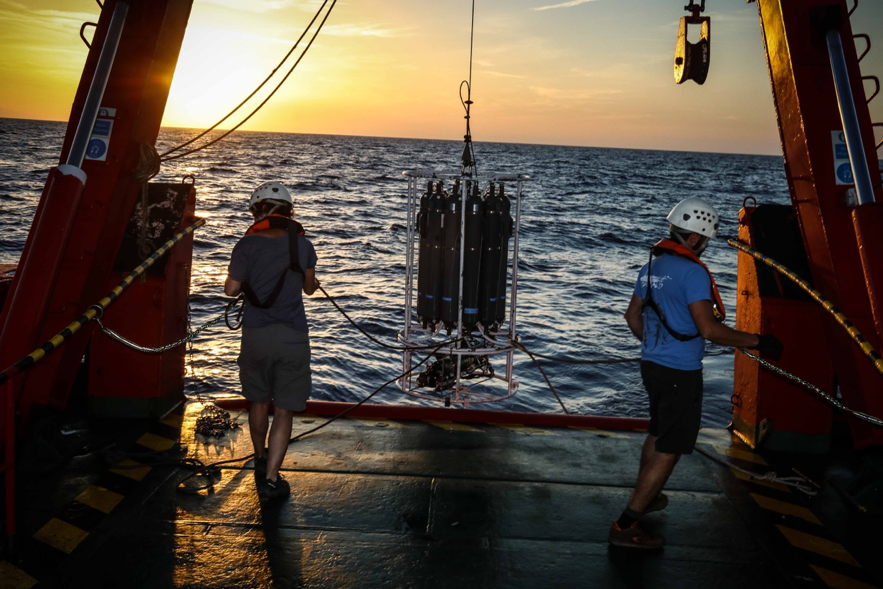Tracking the diversity of Mediterranean Sea microbes from East to West
By Marta Sebastián and collaborators
 Most of Earth’s diversity cannot be seen with the naked eye. Without this invisible diversity, life, as we know it, would not exist since microbes performed (and currently sustain) all the biogeochemical reactions that allowed the appearance of macroscopic life on our planet. Although most people are now aware of the importance of the human microbiome in determining our health, the essential role of microbes for the functioning of any ecosystem is far from being fully recognized. Nevertheless, wherever we look is teeming with microbes. The ocean is no exception, with more than a million of microbial cells in just a milliliter of seawater. Knowing which microorganisms are found in the ocean and what are the factors determining their distribution across different regions and with depth is crucial for predicting how the ocean will adapt to major forthcoming changes in the context of global warming. The Mediterranean Sea is one of the most vulnerable regions to climate change, but the diversity of microbial communities at the whole basin scale had never been explored. In this study, we provide the first basin-wide assessment of prokaryotic (bacteria and archaea) biodiversity in the Mediterranean Sea and adjacent Atlantic waters. We identified more than 12,000 species and studied their distribution from East to West and from the surface to the deep layers. We saw that there is a decrease in the number of species towards the nutrient-poor Eastern Mediterranean. The work reveals that there is a strong spatial segregation of microbial communities throughout the Mediterranean Sea, especially in surface waters and below 1000 meters depth, but not in the intermediate layers. We believe this pattern reflects a strong environmental gradient in surface waters, as well as the isolation of deep water masses due to the presence of the strait of Sicily and the Strait of Gibraltar, that act as physical barriers preventing water mixing. In contrast, communities from the intermediate layers are likely connected through the Levantine Intermediate Water that is formed in the Eastern basin and travels west, exiting the Mediterranean Sea through the strait of Gibraltar.
Most of Earth’s diversity cannot be seen with the naked eye. Without this invisible diversity, life, as we know it, would not exist since microbes performed (and currently sustain) all the biogeochemical reactions that allowed the appearance of macroscopic life on our planet. Although most people are now aware of the importance of the human microbiome in determining our health, the essential role of microbes for the functioning of any ecosystem is far from being fully recognized. Nevertheless, wherever we look is teeming with microbes. The ocean is no exception, with more than a million of microbial cells in just a milliliter of seawater. Knowing which microorganisms are found in the ocean and what are the factors determining their distribution across different regions and with depth is crucial for predicting how the ocean will adapt to major forthcoming changes in the context of global warming. The Mediterranean Sea is one of the most vulnerable regions to climate change, but the diversity of microbial communities at the whole basin scale had never been explored. In this study, we provide the first basin-wide assessment of prokaryotic (bacteria and archaea) biodiversity in the Mediterranean Sea and adjacent Atlantic waters. We identified more than 12,000 species and studied their distribution from East to West and from the surface to the deep layers. We saw that there is a decrease in the number of species towards the nutrient-poor Eastern Mediterranean. The work reveals that there is a strong spatial segregation of microbial communities throughout the Mediterranean Sea, especially in surface waters and below 1000 meters depth, but not in the intermediate layers. We believe this pattern reflects a strong environmental gradient in surface waters, as well as the isolation of deep water masses due to the presence of the strait of Sicily and the Strait of Gibraltar, that act as physical barriers preventing water mixing. In contrast, communities from the intermediate layers are likely connected through the Levantine Intermediate Water that is formed in the Eastern basin and travels west, exiting the Mediterranean Sea through the strait of Gibraltar.Read the full study here:
Marta Sebastián, Eva Ortega-Retuerta, Laura Gómez-Consarnau, Marina Zamanillo, Marta Álvarez, Javier Arístegui, Josep M. Gasol. Environmental gradients and physical barriers drive the basin-wide spatial structuring of Mediterranean Sea and adjacent eastern Atlantic Ocean prokaryotic communities. Limnology and Oceanography 2021, https://doi.org/10.1002/lno.11944
Text written by Marta Sebastián and edited by Clara Ruiz and Félix Picazo
